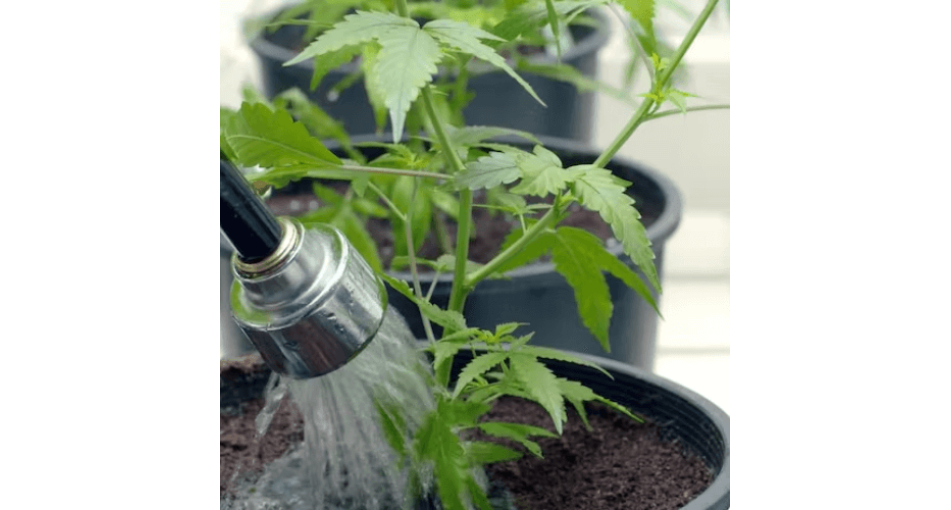
Cannabis is not very picky about water, but you still need to follow the rules of watering to get a good harvest. Lack of water will lead to crop losses, and if it is oversaturated, the crop will stop developing. Therefore, we will tell you how to properly water your cannabis to get the expected results from growing.
Instructions for watering cannabis
Marijuana should be watered in the morning every 2-3 days, depending on the light regime and soil type. Constant moisture can lead to mold and mildew growth, so it's better to underfill rather than overfill.
The need for watering can be determined by weight. Weigh a full container of soil before planting. Then, during cultivation, check the current weight with the original. If the container is heavier, there is still enough water in the substrate and watering is not needed.
Cannabis Irrigation Technique
The irrigation method chosen determines the amount of water absorbed. To get a good harvest, you need to feed the bush from below. The process of such watering is as follows:
Pour water into the stand and place pots with holes in the bottom there;
Wait 30 minutes;
If there is water left on the stand, remove it, if the surface is dry, add a little more and see how much it is absorbed.
If you can not moisten the soil from below, water the bush in the classic way from above. Add water in portions and in small doses so that no liquid remains on the surface. Otherwise, the soil will be sticky.
Watering by irrigation method
Another effective method of watering is the irrigation method. With this technique, the grower knows the exact amount of liquid absorbed by the crop.
To organize such irrigation, you need to connect the irrigator to a water source so that water flows onto each stand in small drops. The pipe through which water flows must be installed no further than 50 m from the pipeline. This method avoids oversaturation with moisture. For unhindered water supply, clean communications in a timely manner.
Water quality requirements
Do not use tap water to water cannabis, filtered water works best. If the liquid in your area contains a lot of sulfur or is too harsh, improve its quality with home filters. The water temperature should be at room temperature.
The quality of the liquid is checked with a pH meter. The optimal range of the parameter is 6.3-6.7, for hydroponics - 5.5. If the water does not meet this requirement, add a chemical to bring the characteristic up to the desired value.
Like all plants, cannabis requires water to perform its basic functions. Water helps plants absorb nutrients from the soil and then travels up the plant and into the leaves, and without it, the plant cannot survive. But giving your marijuana plant the right amount of water can be trickier than you think.
There is no exact science for watering weeds. In most cases, you cannot watch the roots to see if they need water. In addition, the plant is constantly growing and the climate it is in will change, so the amount of water it needs is constantly changing.
Here are some proven tips to help keep your weeds healthy and properly hydrated.
How often should marijuana plants be watered?
A common mistake beginner growers make is overwatering marijuana plants. The cycle of moisture and drying is healthy and necessary for the plant's roots to grow and penetrate deeper into the soil.
In addition, the roots take up oxygen as the soil dries out, and when the soil is too wet, the plant cannot take up oxygen effectively and, in fact, cannot breathe.
The following are general estimates intended to give growers a rough idea of watering frequency; if the plant needs water and goes beyond these limits, water it.
Marijuana watering schedule depending on the stage of the plant
Plant stage Water every # days
Germination 4-7
Seedling 3-7
vegetative 2-4
Bloom 2-3
How to Tell if a Cannabis Plant Needs Watering
The best way to find out if a weed needs water is to:
Stick your finger into the soil 1-2 inches - if it's wet, wait; if it's dry, it's time to water.
You can also pick up a pot and feel its weight to determine if it needs water. This will take some experience - be sure to lift the pots up after watering to get a feel for how heavy they are when full of water. This will also give you an idea of what a light, dry plant is like.
A marijuana plant that is under-watered looks drooping and weak, with yellow or brown leaves; there is no strength in the leaves and they look lifeless.
The leaves of a waterlogged plant look a bit similar in that they hang down, except that the leaves will be dark green and the leaf tips are curled.
Note how often you water your plants and write this down in a journal. Set a watering schedule for your marijuana plants—when they emerge from the seedling stage, watering every two to three days is ideal.
Keep in mind that as plants get bigger, they require more water and need to be watered more frequently.
When growing weeds outdoors, you will need to water more frequently when it gets hotter and less often when it gets cooler.
When you find the sweet spot between too wet and too dry, your plants will thrive.
Best time of day to water weeds
Weeds hold water better in cool, moderate temperatures. During the warmer months, it is best to water the plants early in the morning before the sun is high and late in the evening when the sun is setting. During the cold months, water during the day rather than at night, as cold water can damage the root system.
How much should marijuana plants be watered?
The amount of water that marijuana plants need depends on several factors:
plant size
Outdoor temperature
General well-being
growth stage
How much water do weeds need?
You want to water the plant enough to soak all the soil in the pot. Water should pool on the surface of the soil as you water, and exit through the drainage holes in the bottom of the pot after a couple of seconds. If the water is on the surface of the soil, it means that it is too wet and does not need additional water.
If the weed is very dry, the water will run straight through the soil and pot and out of the drainage holes quickly. If this happens, water the plant a little, and then return to it after 15-20 minutes and water again, and maybe a third time. This allows the soil to slowly absorb water until it is completely wet.
Roots constantly hunt for water as they grow and stretch. As the plant grows, so does the watering radius, the area around the stem of the plant you are watering. This will help guide the roots to the edges of the pot as they search for available nutrients in the soil.
Watering too far from the roots can create standing water, which can lead to root rot, mold, and pest problems.
Is your container the right size?
In order to properly water a cannabis plant, it must be in a container of the correct size, or in a hole large enough if it is in the ground. If the pot is too large, the roots of the plant will not be able to drink water where they cannot reach. If the roots do not absorb water, the water will linger in the soil and take a long time to evaporate, which can promote root rot and unwanted insects and fungi.
Conversely, if the container is too small, the roots will not be able to reach out, which can stop the plant from growing. Less soil also means you will need to constantly water the plant, which adds to the labor.
Ideally, cannabis plants should start in a small pot and progress to larger and larger pots as they outgrow each container. For example, you can grow a seedling or clone in a 4-inch or 1-gallon pot and then move on to a 2-gallon, 5-gallon, 10-gallon, and so on.
Plants are ready to be transplanted when a healthy root structure covers most of the soil and the roots are unbound. When transplanting, pay attention to the quality of the roots: bright white roots with a strong, thick structure are a sign that the plants are being watered properly.
